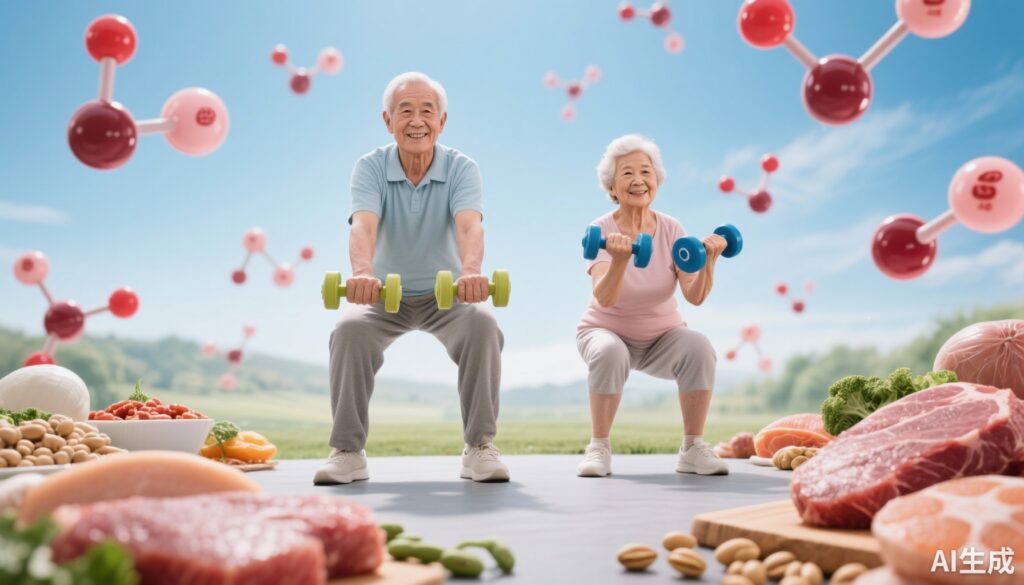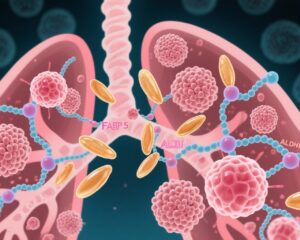Highlight
- A high-protein diet, with or without strength training, does not increase oxidative stress markers in older adults.
- Strength training alone showed no negative effects on blood or oxidative stress parameters.
- Increased urea and blood urea nitrogen levels in the high-protein group remained within normal ranges.
- Women showed more altered oxidative stress markers possibly related to menopausal changes affecting antioxidant defenses.
Study Background and Disease Burden
The global population is aging rapidly, leading to increased prevalence of age-related conditions such as sarcopenia, defined as the progressive loss of muscle mass and function. Sarcopenia contributes substantially to frailty, falls, disability, and decreased quality of life among older adults. A major contributor is physical inactivity, which tends to increase with aging. Evidence supports that both strength training and adequate dietary protein intake are critical strategies to counteract sarcopenia by preserving or improving muscle mass and function.
However, concerns persist regarding potential adverse effects of high-protein diets, particularly related to oxidative stress. Oxidative stress results from an imbalance between reactive oxygen species (ROS) production and antioxidant defenses, contributing to cellular damage and many age-related pathologies. Some studies suggested that high protein consumption might increase oxidative processes. Concurrently, physical exercise modulates oxidative stress markers, but the net impact of combining a high-protein diet with strength training on oxidative stress in older adults remained unclear.
Addressing this knowledge gap is essential for evidence-based nutritional and exercise recommendations in the elderly to promote healthy aging without unintended oxidative damage.
Study Design
The NutriAging Study was a 17-week, single-blind, randomized controlled trial examining the effects of dietary protein intake with or without strength training on oxidative stress markers in older adults. The study enrolled 116 men and women, stratified into three groups:
– Control group (CON): maintained habitual protein intake.
– Recommended Protein group (RP): received protein at recommended daily allowance levels.
– High Protein group (HP): received protein intake exceeding recommended levels.
For the first 6 weeks, dietary interventions were implemented without exercise. Afterward, RP and HP groups underwent a supervised strength training program for the remaining 11 weeks, while CON continued their usual protein intake without exercise intervention.
Blood samples were collected at three time points: baseline (T1), week 8 (T2), and study completion at week 17 (T3). Multiple biochemical parameters and oxidative stress markers were analyzed, including:
– Antioxidant enzymes: superoxide dismutase (SOD), glutathione peroxidase (GSH-Px), catalase (CAT)
– Non-enzymatic antioxidants: glutathione (GSH), glutathione disulfide (GSSG), unconjugated bilirubin (UCB), uric acid (UA)
– Overall antioxidant capacity: ferric reducing ability potential (FRAP)
– Oxidative damage marker: malondialdehyde (MDA)
These markers provide a comprehensive assessment of oxidative stress levels and antioxidant defense status.
Key Findings
The study revealed several important findings concerning protein intake, exercise, and oxidative stress in older adults:
1. No Group-Dependent Increase in Oxidative Stress Markers: All measured oxidative stress parameters changed significantly over time regardless of group allocation, suggesting the influence of external or seasonal factors rather than the interventions themselves.
2. High-Protein Intake Elevated Urea and Blood Urea Nitrogen (BUN): The HP group exhibited significantly increased urea and BUN levels at T2 and T3, logically attributed to higher protein catabolism. Nonetheless, these remained within clinically normal ranges, indicating no renal impairment.
3. Reduction of Unconjugated Bilirubin (UCB) and FRAP in HP: Both UCB and FRAP levels were lower in the HP group compared to controls. This might reflect increased utilization or metabolization of antioxidants in response to the elevated protein intake, though not signifying detrimental oxidative stress.
4. Sex-Specific Effects: Women in the HP group demonstrated more pronounced alterations in oxidative stress markers and reduced serum uric acid compared to men. This phenomenon may be linked to estrogen decline during menopause, potentially decreasing nuclear factor erythroid 2-related factor 2 (NrF2) synthesis, a critical transcription factor regulating endogenous antioxidant enzymes.
5. Strength Training was Safe Concerning Oxidative Stress: The addition of resistance exercise in RP and HP groups did not adversely affect oxidative stress or blood parameters, indicating compatibility of strength training with these dietary approaches in older adults.
6. Overall Safety and Tolerability: None of the interventions led to clinically relevant adverse effects on biochemical or oxidative stress markers, supporting the safety of combined high-protein diets and strength training in this population.
These results underscore that while high-protein diets modulate certain biochemical markers, they do not exacerbate oxidative stress, and strength training adds no oxidative burden in older adults.
Expert Commentary
The NutriAging Study provides valuable evidence addressing prior concerns about protein-induced oxidative stress in the elderly. The rigorous randomized controlled design and comprehensive biochemical assessment strengthen confidence in the findings. Notably, the study highlights the importance of considering sex differences in antioxidant responses, possibly driven by hormonal milieu alterations in postmenopausal women.
From a mechanistic standpoint, the lack of increased oxidative damage markers despite elevated protein metabolism markers suggests efficient antioxidant adaptations or compensatory mechanisms. NrF2’s role warrants further investigation, as its modulation could influence antioxidant enzyme expression and cellular resilience in aging tissues.
Limitations include the single-blind design, potential confounding seasonal effects on oxidative markers, and relatively short duration, which may not capture long-term impacts. Moreover, the study population’s health status and compliance to dietary and training protocols may affect generalizability.
Overall, these findings support current geriatric exercise and nutrition guidelines advocating sufficient protein intake alongside strength training to preserve muscle health without provoking oxidative stress.
Conclusion
In summary, this well-designed trial demonstrates that a high-protein diet, alone or combined with strength training, does not increase oxidative stress markers or cause detrimental biochemical effects in older adults. The interventions are safe and potentially beneficial to counteract sarcopenia, promoting healthy aging.
Clinicians can be reassured about recommending appropriate protein intake and supervised resistance exercise programs in the elderly to improve muscle mass and function without the concern of exacerbating oxidative damage. Future research should explore long-term outcomes, mechanistic pathways especially in women, and personalized nutritional-exercise strategies.
References
Bragagna L, Maqboul L, Baron R, Harloff M, Spasova M, Noori S, Draxler A, Franzke B, Strasser EM, Zöhrer PA, Unterberger S, Aschauer R, Wessner B, Wagner KH. A high-protein diet with and without strength training shows no negative effects on oxidative stress markers in older adults. Redox Biol. 2025 Sep;85:103707. doi: 10.1016/j.redox.2025.103707. Epub 2025 May 30. PMID: 40541063; PMCID: PMC12219370.
Additional literature:
– Cruz-Jentoft AJ, et al. Sarcopenia: revised European consensus on definition and diagnosis. Age Ageing. 2019;48(1):16-31.
– Wu G. Dietary protein intake and human health. Food Funct. 2016;7(3):1251-65.
– Powers SK, Jackson MJ. Exercise-induced oxidative stress: cellular mechanisms and impact on muscle force production. Physiol Rev. 2008;88(4):1243-76.


